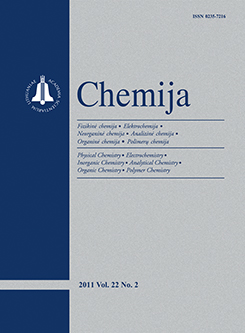Chemija / Chemistry
WHAT?
 ISSN 0235-7216 ISSN 2424-4538 (online) |
2011 m. Nr. 3 Advantages of two-dimensional liquid chromatography in the analysis of complex samples
Two-dimensional (2D) LC–LC separation techniques can be used to significantly increase the number of compounds separated in a single run in comparison with single-dimension separations and to classify a sample on the basis of structural similarities. In-line “comprehensive” LC × LC has experienced a rapid development over the past years, because it allows automatic performance avoiding tedious and time-consuming off-line fraction transfer between the separation systems. Combining different LC separation mechanisms, such as reversed-phase (RP), ionexchange (IEX) and normal-phase (NP) or HILIC chromatography is aimed to accomplish a non-correlated retention with the maximum peak capacity in the time available for the analysis in “orthogonal” two-dimensional LC × LC separation systems. In comprehensive two-dimensional LC × LC, the separation in the second dimension should be accomplished, while the next fraction from the first dimension is collected, usually in less than 1 min. The chemistry of the stationary phase and the composition of the mobile phase in each dimension should match the real-time 2D operation. System incompatibility due to a limited miscibility of the mobile phases and / or too large differences in the elution strengths in the two dimensions should be avoided. Two RP systems with different stationary phases can be combined on-line more easily than an RP system with an NP or HILIC system. Gradient elution significantly increases the number of resolved peaks, both in the first and in the second dimensions. Fast (<1 min) second-dimension gradients with different subsequent time segments improve the overall 2D resolution and separation time. Keywords: two-dimensional LC, comprehensive LC × LC, gradient elution |
Issues:
2017 - Vol.28 No. 1, No. 2, No. 3, No. 4 2016 - Vol.27 No. 1, No. 2, No. 3, No. 4 2015 - Vol.26 No. 1, No. 2, No. 3, No. 4 2014 - Vol.25 No. 1, No. 2, No. 3, No. 4 2013 - Vol.24 No. 1, No. 2, No. 3, No. 4 2012 - Vol.23 No. 1, No. 2, No. 3, No. 4 2011 - Vol.22 No. 1, No. 2, No. 3, No. 4 2010 - Vol.21 No. 1, No. 2-4 2009 - Vol.20 No. 1, No. 2, No. 3, No. 4 2008 - Vol.19 No. 1, No. 2, No. 3-4 2007 - Vol.18 No. 1, No. 2, No. 3, No. 4 2006 - Vol.17 No. 1, No. 2-3, No. 4 2005 - Vol.16 No. 1, No. 2, No. 3-4 2004 - Vol.15 No. 1, No. 2, No. 3, No. 4 2003 - Vol.14 No. 1, No. 2, No. 3, No. 4 2002 - Vol.13 No. 1, No. 2, No. 3, No. 4 2001 - Vol.12 No. 1, No. 2, No. 3, No. 4 |